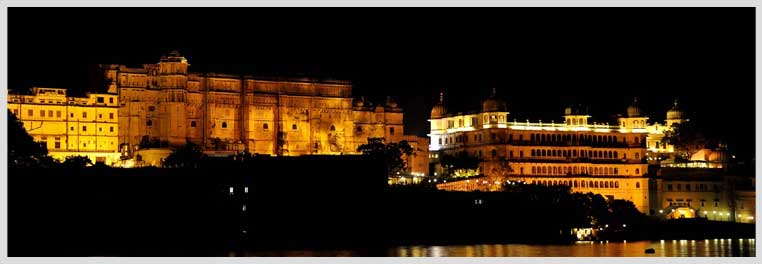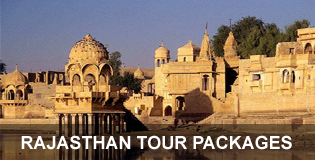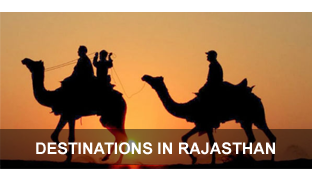Bikaner - Camel Country

If you thrill to the inexorable forces of Nature, do not miss Bikaner. This is a true desert country. You must dismiss any picture post-card ideas of the desert, however. There are few sand-dunes here. The Thar desert is hard, rocky soil, solid as brick. It is scrub-country, not cactus-land. Gorse, thorn, milk-weed sprout precariously and the earth is alive with brazen insects and bolder birds.
This is camel-country. They transport grain, pull heavy carts, work on the wells. Water lies sometimes 122 metres below -the surface. Wells are important, almost sacred. Built on high plinths with slender minareted towers on each of the four corners, these wells proclaim their existence from afar, like a shout of welcome.
The approach to Bikaner is bleak. The wonder is that men have chosen to live here or have thought it worthwhile to risk their lives to: win such, a kingdom. Rao Jodha Rathore of Marwar retrieved the fortunes of his clan and founded the city of Jodhpur in 1459. He had five sons of whom Bikaji was the most lively and enterprising who founded the city of Bikaner. Bikaner is situated directly on the ancient caravan routes that came from Africa and West Asia. It was therefore a great centre of trade in the ancient world. This gave rise to a curious phenomenon. The fortified city of Bikaner is encircled by imposing battlements and stands on a slight eminence. Its roads undulate through colourful bazars and the predominant hue of the buildings is the strong reddish-pink of local sandstone. It is the fourth largest city of Rajasthan.
What to see
Raja Rai Singh (1571-1611 AD), an outstanding General of Mughal Emperor, Akbar, built this imposing fort. It is encircled by a moat and contains palaces made of red sandstone and marble with kiosks and balconies embellishing the structure at intervals. They have impressive mirror work, carvings and paintings.
Suraj Pol, or the Sun Gate is the main entrance to the fort. Har Mandir is the majestic chapel where the royal weddings and births were celebrated.
The palaces worth visiting are Anup Mahal, Karan Mahal, Dungar Niwas, Ganga Niwas and Rang Mahal or Palace of Pleasure. And some of the most beautiful palaces are Chandra Mahal or the Moon Palace which has exquisite paintings on lime plaster walls; and Phool Mahal or the Flower Palace is more elaborately decorated with inset mirror-work. These palaces were built by Maharaja Gaj Singh (1746-87). The palaces within, are adorned with gigantic columns, arches and graceful screens. The facade of the monuments visible above the high invincible walls, offer a splendid view of pavilions protruding out, a row of balconies, kiosks and towers at intervals from a distance.
It was built by Maharaja Ganga Singh to commemorate his father Maharaj Lai Singh. A spellbinding piece of dextrous-carving in red sandstone marked brilliantly by the intricate filigree work. There is a marvellous collection of really old photographs and trophies of wildlife, well preserved and exhibited in the banquet hall. Nature too has enhanced the beauty of this monument. The sprawling lawns are dotted with dancing peacocks and blooming bougainvillaea. Part of the palace today has been renovated to serve as a hotel and the remaining is open for the visitors.
A museum that has an amazing collection. In fact, it is one of the best museums in Rajasthan. There are brilliant examples of pre-Harappan civilisation, the Gupta and Kushan era and sculptures of the late classical time.. It houses a rich collection of terracotta, pottery, carpets, paintings, armoury and coins. There is a separate section of arts and crafts of this region.
There are some pretty parks that can be visited. Public Park, Ratan Bihari Temple Park, Laxmi Nathji Temple Park. There is a zoo in the Public Park. All these places d,eserve inclusion in the itinerary.
Excursions
5 km. Beautiful 16th century Jain temple, dedicated to the 5th Teerthankar Sumtinathji. It has beautiful pillars and painting, on the ceiling.
8 km. This farm, perhaps the only one of its kind in the whole of Asia, is managed by the Central Government. Bikaner's Camel Corps (former Ganga Risala) was a, famous fighting force and still maintains the importance in desert warfare
9 km. It is a royal crematorium with several cenotaphs. Many decorated Chhatris have been built in memory of the rulers of the Bika dynasty. Maharaja Surat Singh's Chhatri is built entirely of while marble with spectacylàr Rajput paintings on its ceiling.
32 km.. It is located on Jaisalmer Road. The lush foliage of the woods have a number of nilgai or the blue bull. Chinkara, black buck, wild boar and flocks of imperial sand grouse that migrate from Siberia to this place in winters. The Gajner Palace, a summer resort of kings, now a hotel, on the banks of a lake, lies within the sanctuary. Many dignitaries of world fame visited this place during the reign of Maharaja Ganga Singh.
30 km. It is a famous temple devoted to Karni Mata, an incarnation of Durga—situated on Jodhpur Road. The temple offers a Sanctuary to rats as they are believed to be incarnated as future bards. Thus, the rats, considered to be sacred, roam freely in the temple precincts. Maharaja Ganga Singh donated massive silver gates, intricately carved and elegantly designed to this temple.
50 km. This pilgrim centre lies on the highway leading to Jaisalmer. The temple here—dedicated to Kapil Muni (Saint)—is the site of a fair in the month of Kartik (October/November). Thousands descend upon this ancient town to bathe in the holy waters of Kolayat lake on the full moon day. A cattle auction and sports involving the camel are major draws at this annual festivity.
| Area : | 38.10 sq km |
|---|---|
| Altitude : | 237 metres |
| Summer : | 44.0CC |
| Winter : | 28.0CC |
| Rainfall : | 31 cm |
| Best Season : | November-February |
| Winter : | Light Woollen |
| Summer : | Light Tiopical |
| Languages : | English, Hindi, Rajasthani (Marwari) |
| Local Transport : | Un metered taxis, auto-rickshaws, cycle-rickshaws and tongas |
Travel Information
Air :'The nearest airport is Jodhpur 243 km.
Rail:Bikaner is connected with Delhi,Jaipur, Jodhpur Udaipur and almost all the major cities of India.
Road :Bikaner is connected by road with the major
Bikaner has its own peculiar items, typical to this region. It is well known for articles made of camel-hide, camel & sheep wool carpets and woollen items, wood and leather products Its Bikaneri bhujia, Rasgullas and sweets are popular all over India Shopping areas include inside Kota Gate, King Edward Memorial Road, Cottage Industries Institute, Station Road, Urmil Trust at Junagarh Fort
The Camel Festival is organised every January. Major attractions include a camel dance and various activities performed by camels Kolayat Fair in November coincides with the Pushkar fair. Gangaur Festival, celebrated in homage to the consort of Lord Shiva Parvati, is held in April Holu is special in Bikaner with festivities beginning several days before the festival,normally held in March.
Other Useful Information
0151
Bank of Rajasthan Tel 27646, Central Bank of India
Tel 26984, Central Cooperative Bank Tel 27073, Punjab National Bank Tel 27206, United Commercial Bank Tel 23911.
Foreign Exchange Counter available at State Bank of Tel 27368, 27034, 27148 and at Ambedkàr Circle Branch.
GPO, Behind Fort; City Post Office, inside Kota Gate
Tourist Reception Centre, RTDC Hotel Dholamaru Tel 27445
Desert Tours, Behind Head Post Office, Rajasthan Safaris & Treks Bassai House, Purani Ginani Tel 28557, Camelman, Opp Sophia School, Jaipur Road Tel 25446
Govt. approved guides for sightseeing can be hired from the Tourist Office at iunagarh Fort or Tourist Reception Centre, Hotel Dhola Maru Campus
Renowned local artists are available and programmes can be arranged by Tourist Officer, on request (with charges)






